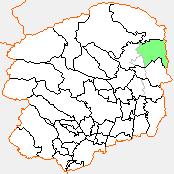Kurobane, Tochigi on:
[Wikipedia]
[Google]
[Amazon]
 was a
was a
ŇĆtawara official website
Dissolved municipalities of Tochigi Prefecture {{Tochigi-geo-stub
town
A town is a type of a human settlement, generally larger than a village but smaller than a city.
The criteria for distinguishing a town vary globally, often depending on factors such as population size, economic character, administrative stat ...
located in Nasu District, Tochigi Prefecture
is a landlocked Prefectures of Japan, prefecture of Japan located in the KantŇć region of Honshu. Tochigi Prefecture has a population of 1,897,649 (1 June 2023) and has a geographic area of 6,408 Square kilometre, km2 (2,474 Square mile, sq mi ...
, Japan
Japan is an island country in East Asia. Located in the Pacific Ocean off the northeast coast of the Asia, Asian mainland, it is bordered on the west by the Sea of Japan and extends from the Sea of Okhotsk in the north to the East China Sea ...
.
During the Edo period
The , also known as the , is the period between 1600 or 1603 and 1868 in the history of Japan, when the country was under the rule of the Tokugawa shogunate and some 300 regional ''daimyo'', or feudal lords. Emerging from the chaos of the Sengok ...
Kurobane developed as the castle town
A castle town is a settlement built adjacent to or surrounding a castle. Castle towns were common in Medieval Europe. Some examples include small towns like Alnwick and Arundel, which are still dominated by their castles. In Western Europe, ...
for Kurobane Domain
was a Han (Japan), feudal domain under the Tokugawa shogunate of Edo period Japan, located in the Nasu District, Tochigi, Nasu District of Shimotsuke Province (modern-day Tochigi Prefecture), Japan. It was centered on Kurobane ''jin'ya'' in what ...
, an 18,000 ''koku
The is a Chinese-based Japanese unit of volume. One koku is equivalent to 10 or approximately , or about of rice. It converts, in turn, to 100 shŇć and 1,000 gŇć. One ''gŇć'' is the traditional volume of a single serving of rice (before co ...
'' feudal domain
A demesne ( ) or domain was all the land retained and managed by a lord of the manor under the feudal system for his own use, occupation, or support. This distinguished it from land sub-enfeoffed by him to others as sub-tenants. In contrast, th ...
under the Tokugawa shogunate
The Tokugawa shogunate, also known as the was the military government of Japan during the Edo period from 1603 to 1868.
The Tokugawa shogunate was established by Tokugawa Ieyasu after victory at the Battle of Sekigahara, ending the civil wars ...
.
As of 2003 the town had an estimated population
Population is a set of humans or other organisms in a given region or area. Governments conduct a census to quantify the resident population size within a given jurisdiction. The term is also applied to non-human animals, microorganisms, and pl ...
of 16,499 and a density
Density (volumetric mass density or specific mass) is the ratio of a substance's mass to its volume. The symbol most often used for density is ''ŌĀ'' (the lower case Greek letter rho), although the Latin letter ''D'' (or ''d'') can also be u ...
of 87.93 persons per km2. The total area was 187.64 km2.
On October 1, 2005, Kurobane, along with the village of Yuzukami (also from Nasu District), was merged into the expanded city of ŇĆtawara
is a Cities of Japan, city located in Tochigi Prefecture, Japan. , the city had an estimated population of 72,189 in 30,136 households, and a population density of 210 persons per km2. The total area of the city is . The city's name may also b ...
.
References
External links
ŇĆtawara official website
Dissolved municipalities of Tochigi Prefecture {{Tochigi-geo-stub